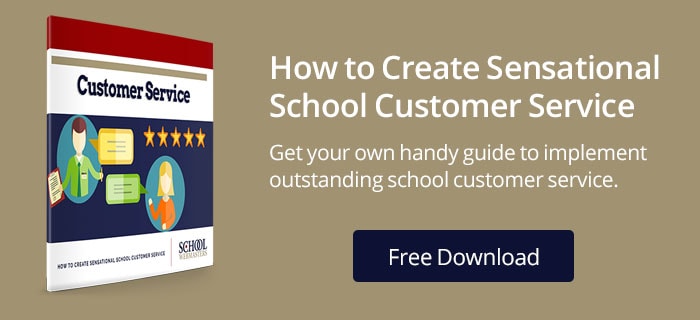Criticism and negativity can be a minefield when it comes to your school public relations. Remember, school public relations refers to how your community views and feels about your school; in other words, it’s your reputation. We all strive to have favorable public relations, but when something goes wrong, how we respond can make or break our reputation.
In part 2 of our school customer service series, we’ll take a look how to deal with difficult or upset persons as well as how to deliver constructive criticism. These valuable customer service skills will help you gain the positive school public relations for which you strive.
As a school administrator, it is in your best interest to invest in a healthy plan of school communication. When moments of difficulty present themselves, it is possible to turn a challenge into an opportunity by using certain tools that grow more effective with practice. Let’s look at key components to such opportunities as well as how to receive or deliver constructive criticism in a way that ensures both sides win.
Download our FREE eBook: How to Create Sensational School Customer Service.
A Recipe for Active Listening
When a parent, community member, staff member, or even board of education member is voicing a complaint, criticism, or concern, the first step is to listen. We’ve all heard how important it is, in any of our relationships, to become a better listener. This means becoming an active listener. Remember, your customers want to voice their grievances and be heard—so listen intently.
Consider a neutral statement to begin. For example, one that keeps you from becoming defensive and lets them know you are ready to listen could be, “Please tell me what happened.” Steer clear of jumping to conclusions about what occurred; just let your customer tell you their story. As you listen, avoid interrupting, planning your response, and making assumptions. Just listen.
Our mind tends to bounce around, making it difficult to focus on one thing for more than a few minutes. While “listening,” we might think about what we are going to say next or simply jump to conclusions about what the speaker is really saying. Sometimes, we are even thinking about something totally unrelated to the conversation taking place.
These are all very natural human responses, and they are at the heart of most miscommunication. If we work at it, however, we can train ourselves to stay focused, concentrate on the message, ask questions, reflect, and paraphrase—and become excellent listeners. This will help us in both our professional and personal lives.
When your customers (publics, audience, stakeholder, whatever term you choose) feel listened to, it improves your school public relations even if something has gone wrong.
Central aspects of active listening:
- Pay Attention: If the conversation is face-to-face, look at the speaker directly. Set aside any distracting thoughts; you may find it helpful to repeat in your mind the words being spoken to help connect you with the moment. Avoid mentally preparing your response. And don’t let other environmental factors distract you. For example, don’t check your phone or computer.
- Show That You’re Listening. In face-to-face interactions (including video conferences), nod occasionally, and include smiles and other facial expressions. Is your posture open and inviting? Encourage the speaker to continue with small verbal comments like “yes” and “uh huh.”
- Provide Feedback. Take time to rephrase the key points of what the other person has said, reflecting back in your own words, often in the form of a question. Reflect on what has been said by paraphrasing. “I understand you to mean…” or “So, it sounds like you are saying…” or “If I understand it right….” or “What I’m hearing from you is…” are great ways to begin your feedback about what you heard as well as give the speaker a chance to clarify. Ask questions on points where clarification is needed, “What do you mean when you say…” or “Is this what you mean?” During the conversation, occasionally paraphrase the speaker’s comments.
- Defer Judgment. Avoid interrupting. It is simply a waste of time. Interrupting will very likely frustrate the speaker and keep you from understanding the message. Allow the speaker to finish before you begin to ask questions. If you are concerned you might forget your questions, jot them down and ask them when they finish.
- Respond Appropriately. Active listening helps you gain perspective as well as information. It is, indeed, a model for respect and understanding—worth the effort to perfect. Examine your willingness to be candid, honest, and kind in your responses. Treat the speaker the way you would want to be treated.

Central aspects of active listening:
Taking Criticism
Beyond active listening, other valuable tools come in handy when facing an angry parent, student, community member, or staff.
- Change Your Attitude: We often become defensive and put up a wall when we or something we care about is the subject of criticism. Instead, try to put yourself in their shoes. Set aside feelings you may have about how they are approaching you (even if the way they are acting upsets you or seems unreasonable or unfair). As you try to see the circumstance from their perspective and put your personal feelings aside, you will be more likely to focus on them and the present circumstance.
- Restate Their Concerns: Once your customer has explained what happened, express your understanding of the current situation/concern. Choose your words carefully, using calm and objective wording. (For example, “So, it sounds like…”) As you repeat back the problem, it shows your customer that you were listening and committed to solving the problem. The result will be a decrease in their stress or anger level.
- Find Common Ground: It is possible to understand why someone is upset. You can understand how they feel without taking the blame. It is alright to express this. By acknowledging your understanding, this does not mean you are admitting to a mistake, merely that you understand how they feel. You may show empathy by saying something like, “I understand why you are upset. I’m very sorry that ______.” Or, “I’m really sorry this caused a problem for you.”
- Present a Solution: If you feel like you know what will make your customer happy, let them know how you’d like to correct the situation. You could say something like, “Let me take care of _____________ right now.” Or, “I was thinking we should ________, will that work?” If you are not sure what the customer wants from you, or if they reject your proposed solution, give them power to resolve the problem. Ask them to suggest ideas of how they would like you to resolve it. For example, “I’d love to hear what you think we should do to get this fixed correctly. If it is within my power, I’ll take care of it, and if not, then we can work on another solution together.”
- Take Action & Follow Up. Once you’ve both come to a solution, take action immediately. And once the situation has been resolved, follow up with your customer, ensuring they’re happy with the resolution. Whenever you can, go above and beyond their expectations. You might even write a personal, handwritten note if you feel it is appropriate.
- Use the Feedback: If possible, make sure the situation doesn’t happen again in the future. If you haven’t already done so, identify how the problem started in the first place. Consider possible steps to put in place in order to improve the process so a future problem can be avoided. If it is a mistake made by someone outside of your responsibility, provide the details and any recommendations you might have with a supervisor.
Delivering Criticism
As a school administrator, you oversee the public relations practices of many of your staff. Sometimes those with whom you interact will expect something that you know by your own experience is not possible or will not be as effective as they think. Sometimes they won’t see issues or concerns through the same lens you see them, especially when it comes to school communications.
It’s your job to help your staff improve by offering helpful suggestions, instead of simply going along with the way things have always been. There’s a fine line here, since your relationship with others is connected to many facets of your school. Keep in mind, you are in your current position because you are qualified and knowledgeable and others welcome your input and feedback. Those with whom you interact will welcome your suggestions more if you tactfully present your recommendations using a positive approach.
- The Compliment Sandwich Method.
The compliment sandwich is a common method for delivering criticism. It involves “sandwiching” clear and direct criticism between compliments. For example, you provide positive feedback on an aspect of a staff member’s performance, then bring up an area where improvement is needed, and end the conversation with more positive praise.
The compliment sandwich has declined in popularity, in recent years, with many voices saying compliments sound dismissive when paired with criticism. However, when done right, a compliment sandwich can deliver feedback for needed improvements in a tactful, encouraging way.
For example, let’s say you notice your front office secretary isn’t as welcoming as she ought to be. She’s very busy and puts off that “busy air” as guests come to the front desk, taking a while before she acknowledges them. Though you’ve discussed wanting to provide a friendly, welcoming environment as guests visit your school, you notice she hasn’t made any strides toward improvement.
Old Method: You might say, “Sharon, I’ve noticed you haven’t made efforts to be more friendly and welcoming. Please remember that you provide the first impression for guests when they visit our school and we’re counting on you to do a better job.”
Compliment Sandwich: “Sharon, you do a wonderful job keeping the day-to-day activities of our school running. I understand how busy you are, but I’m afraid that may be detracting from the friendly, welcoming environment we want to offer as guests visit the front desk. Do you think you could be more conscientious when guests approach the desk to acknowledge them, even if you have something to finish up before you can help them? A friendly, ‘I’ll be with you in just a moment’ goes a long way. You have such an affable personality, I know you’ll do a wonderful job helping us toward our goal of having a welcoming front office.”
The compliment sandwich method takes a bit more time but is an effective way to introduce recommendations and guide co-workers and team members in a kind manner. Just be sure to remember this: all feedback (positive and negative) must be well thought out and authentic. - For example, in the example above a delayed compliment sandwich may sound like this: “Sharon, I know how busy you are and you do a wonderful job keeping the day-to-day activities of our school running. But I’ve noticed that you sometimes ignore guests at the counter. Could you please be more conscientious when guests approach the desk to acknowledge them? A friendly, ‘I’ll be with you in just a moment’ goes a long way.”
After a week, when Sharon has made a visible effort to follow through with your request, you could say, “I’ve noticed you doing a really great job recently! Thank you for helping us make this a welcoming environment!” - Guided Questions
Another method for providing constructive criticism is to pose questions and work together to determine the problem and develop a solution.
Using the same situation as an example you might say, “A few weeks ago we discussed wanting to provide a more welcoming and friendly environment for our guests. Sharon, what are some things you could do to help us reach that goal?”
I love this method because it allows the person receiving feedback an opportunity for introspection and the chance to develop their own solution. You also can offer feedback in a way that shows you are on the same page and willing to help in their improvement.
By tactfully and helpfully providing criticism, you construct a happy, healthy work environment. An environment in which your employees are happy and enjoy their jobs is a crucial piece to good public relations. It’s hard to explain, but think about it this way: Happiness is contagious; if your employees are happy, it emits through their interactions with your customers and results in positive public relations for your school.

Final Thoughts
A critical aspect of your school’s customer service is how you as an administrator face the criticism from others as well as provide feedback yourself. When these opportunities come, remember to take the advantage and connect with the people involved using tools and principles such as those mentioned here. These recommendations aren’t always easy to practice in moments of frustration, but if you strive to handle all situations with kindness and empathy, when difficult situations arise you’ll be practiced in your response and have a better chance at maintaining those positive public relations for which we all strive.
As you interact with those in your school community in a positive, constructive way, you further establish a school brand/reputation people will want to get behind. And that’s something we all like to hear!
Oh, and don’t forget to check out Part 1 and Part 3 of this 3-part school customer service series.

Emily Boyle, School Content Manager








